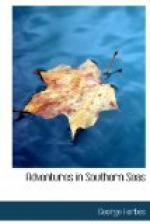At twenty minutes past ten the ship floated, but the leak she had sprung gained on the pumps, and there was now three feet nine inches of water in the hold. The men were wearied to death. Each could only pump a few minutes at a time, and then sink exhausted upon the deck. At first we despaired of saving the ship, but eventually we got a sail drawn over the leak, and anchored seven leagues from the shore. Next day we found a safe place where the vessel could be moored near the beach, where, on examining the ship’s bottom, we found that a large piece of rock had broken away from the reef and remained stuck in the hole it made. Had it not been for this singular fact the “Golden Seahorse” must have foundered.
During the week which followed this adventure, which had almost proved disastrous to our voyage, we lightened the ship as much as possible, and made our camp ashore. We judged we had now come to the coast of New Holland, and since I had been the first to observe it on the morning after we had struck upon the reef, Hartog named that part of the coast Peter’s land.
The ship being safely careened, the carpenters set to work to repair the damage done to the hull by the sharp rocks, and, as this would occupy some time, we decided to overhaul our stores, of which we made an inventory. At this work we found the services of Pedro de Castro of great value. De Castro was a man well versed in figures, and able to enumerate with surprising facility. Indeed, I think he spent most of his spare time in mental arithmetic, calculating the riches and treasure which he hoped some day to obtain.
One evening, when Hartog and I were seated together in front of our tent, de Castro brought us a paper which he said had been given him by a relative at Lisbon, who informed him that it was an extract from an ancient Portuguese manuscript, supposed to have been written by navigator Van Nuyts in 1467. The translation of this curious paper ran as follows:
“Land of Gold. While some fishermen of Lamakera, in the island of Solo, were engaged in their fishing, there arose so great a tempest that they were unable to return to the shore. Thus they yielded to the force of the storm, which was such that, in five days, it took them to the Land of Gold, which is properly called the Southern Coast. When the fishermen reached the Land of Gold, not having eaten during those days of tempest, they set about seeking for provisions, and such happy and successful fortune had they after searching the country for yams and batatas, that they alighted on much gold in a cavern, enough to load their boats until they could carry no more, but, when they were ready to start loading, there came upon them so great a trepidation that they did not dare take any of the gold away with them.”
This further account of gold upon the Southern Continent strengthened our belief that treasure would be found at the place of the painted hands, to visit which our present voyage had been undertaken. But what could have caused the fishermen of Lamakera so great a trepidation we were at a loss to understand. Well, perhaps we would soon learn, for Hartog reckoned we were not many leagues north of the place marked upon the chart, which had encouraged us to embark upon this voyage.




